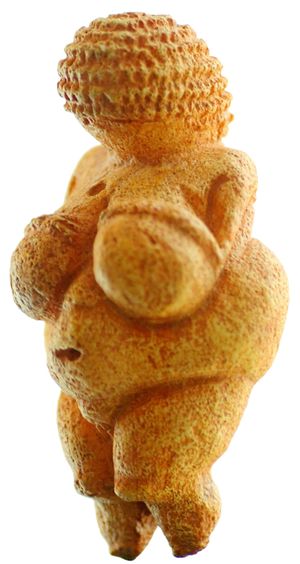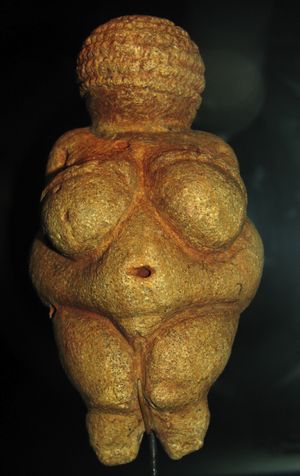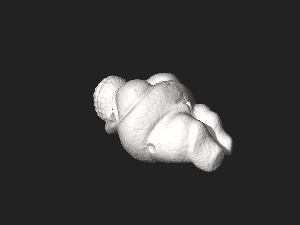ڤينوس ڤيلندورف
| ڤينوس ڤيلندورف | |
|---|---|
 | |
| الخامة | حجر جيري Oolitic |
| أنشئت | ح. 28,000 ق.م. – 25,000 ق.م. |
| أُكتشفت | 7 أغسطس 1908 بالقرب من ڤيلندورف، على يد يوسف سومباتي |
| الموقع الحالي | متحف التاريخ الطبيعي (ڤيينا), ڤيينا، النمسا |
ڤينوس ڤيلندورف Venus of Willendorf هي 11.1-centimetre-tall (4.4 in) Venus figurine estimated to have been made 30,000 BCE.[1][2] It was found on August 7, 1908 by a workman named Johann Veran[3] or Josef Veram[4] during excavations conducted by archaeologists Josef Szombathy, Hugo Obermaier and Josef Bayer at a paleolithic site near Willendorf, a village in Lower Austria near the town of Krems.[5][6] It is carved from an oolitic limestone that is not local to the area, and tinted with red ochre. The figurine is now in the Naturhistorisches Museum in Vienna, Austria.[7]
. . . . . . . . . . . . . . . . . . . . . . . . . . . . . . . . . . . . . . . . . . . . . . . . . . . . . . . . . . . . . . . . . . . . . . . . . . . . . . . . . . . . . . . . . . . . . . . . . . . . . . . . . . . . . . . . . . . . . . . . . . . . . . . . . . . . . . . . . . . . . . . . . . . . . . . . . . . . . . . . . . . . . . . .
التأريخ
The figure is believed to have been carved during the European Upper Paleolithic, or "Old Stone Age", a period of prehistory starting around 30,000 BCE.[6] A wide variety of dates have been proposed. Following a revised analysis of the stratigraphy of the site where the statuette was discovered, carried out in 1990, the figure was estimated to have been carved between 24,000 and 22,000 BCE.[5] More recent estimates push the date back slightly to between about 28,000 and 25,000 BCE. In a 2009 reexamination of the stratigraphy at the site, researchers estimated that the age of the archaeological layer in which the figurine was found is about 30,000 years before our time.[1]
التفسير والغرض
Similar sculptures, first discovered in the nineteenth and early twentieth centuries, are traditionally referred to in archaeology as "Venus figurines", due to the widely-held belief that depictions of nude women with exaggerated sexual features represented an early fertility fetish, perhaps a mother goddess. The reference to Venus is metaphorical, since the figurines predate the mythological figure of Venus by many thousands of years. Some scholars reject this terminology, instead referring to the statuette as the "Woman of" or "Woman from Willendorf".[8] Christopher Witcombe criticizes the term: "the ironic identification of these figurines as 'Venus' pleasantly satisfied certain assumptions at the time about the primitive, about women, and about taste".[9]
Very little is known about the Venus' origin, method of creation, or cultural significance; however, it is one of numerous "Venus figurines" surviving from Paleolithic Europe.[10] The purpose of the carving is the subject of much speculation. Like other similar sculptures, it probably never had feet, and would not have stood on its own, although it might have been pegged into soft ground. Parts of the body associated with fertility and childbearing have been emphasized, leading researchers to believe that the Venus of Willendorf may have been used as a fertility fetish.[10] The figure has no visible face, her head being covered with circular horizontal bands of what might be rows of plaited hair, or perhaps a type of headdress.[11]
Catherine McCoid and LeRoy McDermott hypothesize that the figurines may have been created as self-portraits by women. This theory stems from the correlation of the proportions of the statues to how the proportions of women's bodies would seem if they were looking down at themselves, which would have been the only way to view their bodies during this period. They speculate that the complete lack of facial features could be accounted for by the fact that sculptors did not own mirrors. This reasoning has been criticized by Michael S. Bisson, who notes that water pools and puddles would have been readily-available natural mirrors for Paleolithic humans.[12]
انظر أيضاً
المراجع
- ^ أ ب Antl-Weiser, Walpurga (2009). "The time of the Willendorf figurines and new results of palaeolithic research in Lower Austria". Anthropologie. Brno. 47 (1–2): 131–141.
- ^ Harris, Beth; Zucker, Steven (May 27, 2012). Nude woman (Venus of Willendorf) (Video). Smarthistory – via YouTube.
- ^ Antl-Weiser, Walpurga. "The anthropomorphic figurines from Willendorf" (PDF). Wissenschaftliche Mitteilungen Niederösterreichisches Landesmuseum. 19: 19–30.
- ^ Bibby, Geoffrey (1956). The Testimony of the Spade. New York: Alfred A. Knoff. p. 139.
- ^ أ ب Venus of Willendorf Christopher L. C. E. Witcombe, 2003.
- ^ أ ب John J Reich; Lawrence Cunningham (2013) Culture and Values: A Survey of the Humanities, 8th Ed., Andover, Belmont, CA ISBN 978-1-133-95122-3
- ^ Witcombe, Christopher (2003) Venus of Willendorf, retrieved 2008
- ^ Venus of Wllendorf, Encyclopædia Britannica; Dictionary of Women Artists.
- ^ "Name". Christopher L. C. E. Witcombe, 2003.
- ^ أ ب Lawrence Cunningham; John J Reich (2006). Culture and values : a survey of the humanities. Belmont, CA: Wadsworth. ISBN 978-1-133-94533-8.
{{cite book}}: CS1 maint: multiple names: authors list (link) - ^ "Woman from Willendorf". Christopher L. C. E. Witcombe, 2003: "The rows are not one continuous spiral but are, in fact, composed in seven concentric horizontal bands that encircle the head and two more horizontal bands underneath the first seven on the back of the head."
- ^ McDermott, LeRoy (1996). "Self-Representation in Upper Paleolithic Female Figurines". Current Anthropology. 37 (2): 227–275. JSTOR 2744349.
وصلات خارجية
- Christopher L. C. E. Witcombe, "Women in Prehistory:Venus of Willendorf".
- Don Hitchcock (Don's Maps): "Venus figures from the Stone Age - The Venus of Willendorf"
- The Invisible Sex: Uncovering the True Roles of Women in Prehistory by J.M. Adovasio, Olga Soffer and Jake Page, ISBN 978-0-06-117091-1, gives a new 'view' of headdress as possible model for weaving a basket; Lauran Miller review at Salon.com: [1]
- Pages using gadget WikiMiniAtlas
- Coordinates on Wikidata
- Venus figurines
- ڤينوس ڤيلندورف
- 1908 في النمسا
- Archaeological artefact types
- Upper Paleolithic Europe
- اكتشافات أثرية في النمسا
- نمسا العصر الحجري
- Stone sculptures in Austria
- Archaeology of Lower Austria
- Limestone sculptures
- اكتشافات أثرية في 1908
- آثار أوروبية

